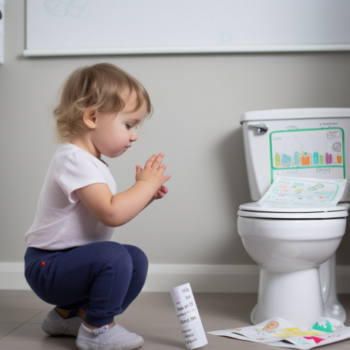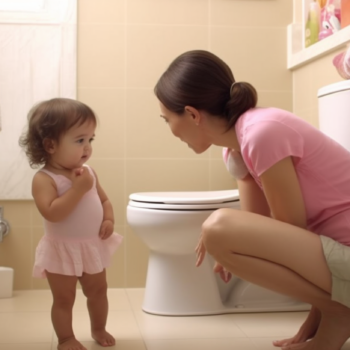When it comes to nighttime potty training, many parents wonder if they should use diapers or pull-ups. While both options have their benefits, it ultimately depends on your child's individual needs and habits. Diapers may be more absorbent and provide better protection for heavy wetters, while pull-ups offer a more underwear-like feel and can help with the transition to underwear during the day. Ultimately, it's important to consider your child's comfort and choose the option that works best for them. Keep in mind that nighttime accidents are common during potty training, so patience and consistency are key.
Tag: pull-ups
Nighttime Potty Training: Tips to Prevent Accidents and Ensure Restful Sleep for Your Child
Nighttime potty training can be a challenging task for parents. Accidents can happen, but there are things you can do to prevent them. First, make sure your child goes to the bathroom right before bedtime. Limit drinks before bedtime and avoid caffeine altogether. Consider using overnight diapers until your child can stay dry consistently. Use a nightlight or leave the bathroom light on to make it easier for your child to see where they are going. And finally, be patient and understanding. Accidents are normal during nighttime training and the process can take time. With these tips, you can help prevent accidents and make nighttime potty training a smoother process for you and your child.
Understanding Potty Training Readiness in Girls: Signs to Look Out For
As a parent, it can be difficult to determine when your little girl is ready to start potty training. However, there are some key signs to look out for that indicate she may be ready to start. For example, if she is able to communicate her needs effectively, shows interest in the bathroom, and can stay dry for longer periods of time, these are all great indications that she is potty training ready. Additionally, if your little girl is able to follow simple instructions and has predictable bowel movements, these are also great signs that she may be ready for this important milestone. By paying attention to these signs, you can help your daughter successfully navigate the potty training process and achieve success.
The Ultimate Guide: When Should You Expect Your Child to be Fully Potty Trained?
Potty training is a significant milestone for both parents and children. However, there is no fixed age when a child should be fully potty trained. While some children may be ready at 18 months, others may not be ready until they are three or even four years old. It's important to understand that every child is different and may have their own pace when it comes to potty training. As a parent, it's essential to be patient and supportive throughout the process. With proper guidance and encouragement, your child will eventually master this essential skill.
Understanding the Signs of Toddler Readiness for Potty Training
Potty training can be a daunting task for parents, but it doesn't have to be. The key is to wait until your child is developmentally ready. Signs of readiness include showing interest in the bathroom, being able to communicate when they need to go, and having the physical ability to control their bladder and bowel movements. Timing is also important - don't start too early or too late. By waiting for the right cues and being patient, potty training can be a successful and positive experience for both you and your little one.
The Ultimate Guide to Potty Training: Average Timeframes and Tips for Success
Potty training is a major milestone for parents and children alike. However, there is no set timeline for how long it takes to potty train a child. The process can range from a few days to several months. Some factors that can affect potty training include your child's age, temperament, and readiness. It's important to remember that every child is different and may require a unique approach to potty training. By understanding the process and being patient, you can help your child successfully transition to using the toilet independently.
Discover the Top Potty Training Products for Effective Results
Potty training is a big milestone for both parents and toddlers. However, it can be a challenging process without the right tools and products. There are various potty training products available in the market such as potty chairs, toilet seat adapters, training pants, and reward charts. Choosing the best potty training products can make all the difference in your child's potty training journey. In this blog post, we will explore the top potty training products that are effective, affordable, and easy to use. From fun and colorful potty chairs to eco-friendly and reusable training pants, we've got you covered. So, read on to discover the best potty training products that will help your child master this important milestone in no time.
Expert Tips for Dealing with Potty Training Accidents in Girls
Potty training can be a challenging time for parents and accidents are a common occurrence. When it comes to potty training girls, accidents can happen for a variety of reasons, including physical and emotional factors. It's important to handle accidents with patience, understanding, and a positive attitude. In this blog post, we'll share tips and strategies for dealing with accidents during potty training for girls. From creating a supportive environment to using positive reinforcement, we'll cover everything you need to know to make potty training a success for your little girl.
Potty Training Timeline: How Long Does It Take to Successfully Train a Child?
Potty training is a significant milestone for both parents and children. However, the duration of the process varies for different children. Some may take a few days, while others may need several months or even longer. Factors such as age, temperament, and readiness play a crucial role in determining how long it takes to potty train a child. Nevertheless, it is important to be patient and consistent in the process, as pushing a child too hard or rushing them can lead to regression. With the right approach, encouragement, and rewards, most children can successfully transition from diapers to using the toilet in due time.
A Comprehensive Guide to Determine Your Child’s Potty Training Readiness
Potty training is an important milestone in a child's development, but it can be challenging for both the child and parent. It's important to know if your child is ready before starting the process. Some signs that your child may be ready include showing interest in the potty, being able to stay dry for a few hours, and being able to communicate their needs effectively. It's important to be patient and positive during the process, as every child is different and may take longer to master this skill. By following your child's cues and providing plenty of encouragement and support, you can help them successfully navigate this important stage in their development.


